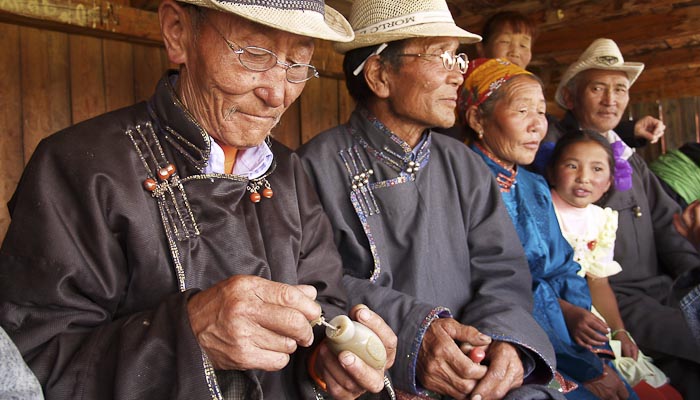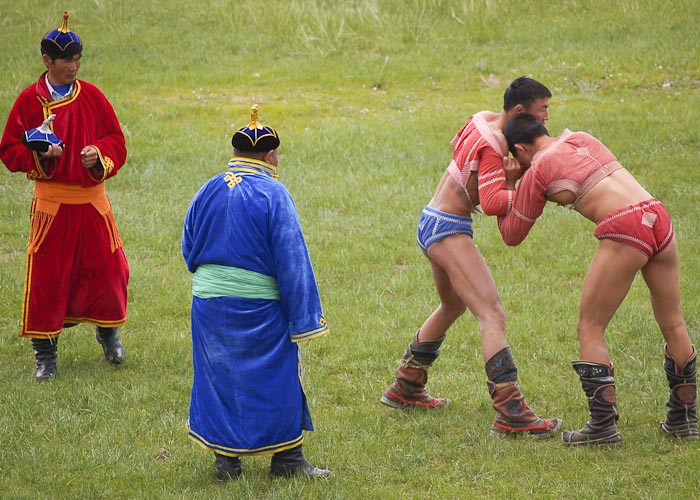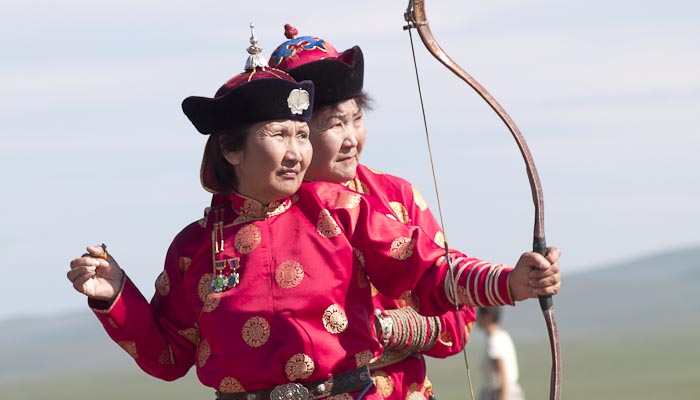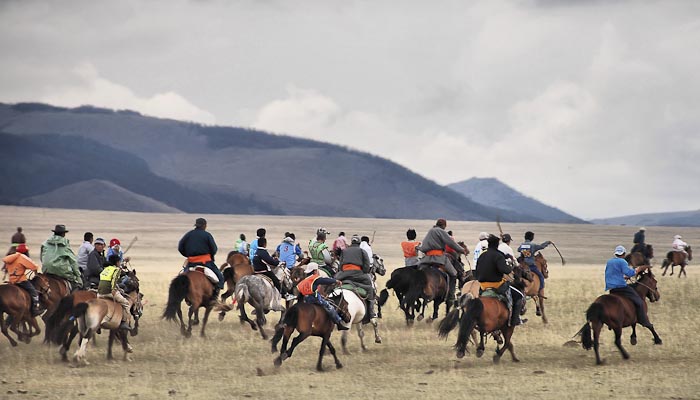Experience Naadam
The Naadam Festival is the biggest event of the Mongolian year! Naadam, which means "games", is celebrated in every town and rural district across the country. The National games in Ulaanbaatar are held between the 11th & 13th July every year, but dates vary outside of the capital. The festival features the three manly sports: wrestling, archery and horse racing. The strongest wrestlers, fastest horses and expert marksmen come together to compete for National and regional titles. Local festivities and merry-making are also key feature - something that everyone's encouraged to participate in! All generations come together to celebrate this annual festival.

WRESTLING
Wrestling is viewed by Mongolians as holding very important cultural status and seen as embodying ancient values of nobility, strength and sportsmanship. Their competition rituals are believed to have passed down in a form virtually unchanged for hundreds of years. The object of a wrestling match is to get your opponent to touch his back, head, knee or elbow to the ground. This essentially means that any part of the body other than the feet or hands which touches the ground signals defeat.
There are no weight classes or time limits in a match. Each wrestler must wrestle once per knock-out round – the winners moving onto the next round. A variety of throws, trips and lifts are employed to topple an opponent. Grabbing one’s opponent’s legs is completely legal. However, deliberate striking, strangling or locking is illegal. If both wrestlers fall together, the first wrestler to touch the ground – regardless of who threw whom – is the loser.
There are many rituals wrestlers observe throughout the contest. Each wrestler has a “zasul” who is both coach and second. Wrestlers slap the front of their thighs twice, and once on their backside, to show that they are ready to begin. Each then strides forward imitating a large bird taking off, known as the traditional ‘eagle dance’. This symbolises power and invincibility, and is based on the flight of the mythical Garuda bird. The wrestler then finishes the dance by approaching his zasul in the middle of the arena, who removes the wrestler’s hat as he bows his head. The match then commences. During lulls in the match the zasuls may slap their wrestler on the backside and shout words of encouragement.
If a wrestler loses the match he symbolically unties his top and passes under the arm of the winner as a sign of respect. The winner then again performs his eagle dance in front of his supporters and the rest of the crowd.

ARCHERY
Archery can be traced back thousands of years, where it played a large part in the rise and fall of empires. Archers use a bent composite bow made of layered horn, bark, and wood. Usually arrows are made from willow trees and the feathers are from vultures and other birds of prey.
Traditionally dressed male archers stand 75 yards from the target, while women archers stand 60 yards away. The target is a line-up of round leather rings on the ground. Usually there are only about 20 or 30 rings. After each shot, special judges who stand near the target emit a short cry called an “Uukhai”, and raise their hands in the air to indicate the quality of the shot. The winner is the archer who hits the target the most times with the allotted number of arrows, and is declared the best archer or “Mergen”.

HORSE RACING
Mongolian horse racing is a cross-country event, with races 15–30km long. The length of each race is determined by age class. For example, two-year-old horses race for ten miles and seven-year-olds for seventeen miles. Up to 1,000 horses from any part of Mongolia can be chosen to participate.
Children from seven to thirteen years of age are chosen as jockeys and train in the months preceding the races. While jockeys are an important component, the main purpose of the races is to test the skill of the horses.
Before the races begin, the jockeys sing a song called “Gingo”. Prizes are awarded to horses and jockeys. The top five horses in each class are honoured and the top three are given gold, silver, and bronze medals. The winning jockey is praised with the title of “Tumny Ekh” or leader of ten thousand. The horse that finishes last in the two-year-old horses race is called “Bayan Khodood”, meaning "full stomach". A song is sung to the Bayan Khodood wishing him luck to be next year's winner.
Melissa, one of our travel designers, has written a blog about her visit to a Naadam Festival. Read it here.

Let us know if you would like to incorporate a Naadam into your journey. It can be a busy time so best to book early if you want to avoid disappointment.

